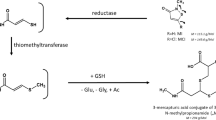Abstract
It has been previously reported that treatment of urinary oxazepam by commercial β-glucuronidase enzyme preparations, from Escherichia coli, Helix pomatia and Patella vulgata, results in production of nordiazepam (desmethyldiazepam) artefact. In this study, we report that this unusual reductive transformation also occurs in other benzodiazepines with a hydroxyl group at the C3 position such as temazepam and lorazepam. As determined by liquid chromatography-mass spectrometry analysis, all three enzyme preparations were found capable of converting urinary temazepam into diazepam following enzymatic incubation and subsequent liquid–liquid extraction procedures. For example, when H. pomatia enzymes were used with incubation conditions of 18 h and 50 °C, the percentage conversion, although small, was significant—approximately 1% (0.59–1.54%) in both patient and spiked blank urines. Similarly, using H. pomatia enzyme under these incubation conditions, a reductive transformation of urinary lorazepam into delorazepam (chlordesmethyldiazepam) occurred. These findings have both clinical and forensic implications. Detection of diazepam or delorazepam in biological samples following enzyme treatment should be interpreted with care.









Similar content being viewed by others
References
Schwartz RH, Milteer R, LeBeau MA (2000) South Med J 93:558–561
Rickert VI, Wiemann CM, Berenson AB (2000) J Pediatr Adolesc Gynecol 13:37–42
Scott-Ham M, Burton FC (2005) J Clin Forensic Med 12:175–186
ElSohly MA, Gul W, Murphy TP, Avula B, Khan IA (2007) J Anal Toxicol 31:505–514
Woods JH, Winger G (1995) Psychopharmacology 118:107–115
Stewart SH, Westra HA (2002) Curr Pharm Des 8:1–3
Mandrioli R, Mercolini L, Raggi MA (2008) Curr Drug Metab 9:827–844
Langner JG, Gan BK, Liu RH, Baugh LD, Chand P, Weng JL, Edwards C, Walia AS (1991) Clin Chem 37:1595–1601
Laloup M, Fernandez MDMR, Wood M, Maes V, De Boeck G, Vanbeckevoort Y, Samyn N (2007) Anal Bioanal Chem 388:1545–1556
Pavlic M, Libiseller K, Grubwieser P, Schubert H, Rabl W (2007) Int J Leg Med 121:169–174
Schubert B, Pavlic M, Libiseller K, Oberacher H (2008) Anal Bioanal Chem 392:1299–1308
Joyce JR, Bal TS, Ardrey RE, Stevens HM, Moffat AC (1984) Biomed Mass Spectrom 11:284–289
Maurer H, Pfleger K (1987) J Chromatogr A 422:85–101
Japp M, Garthwaite K, Geeson AV, Osselton MD (1988) J Chromatogr A 439:317–339
ElSohly MA, Feng S, Salamone SJ, Wu R (1997) J Anal Toxicol 21:335–340
Fu S, Lewis J, Wang H, Keegan J, Dawson M (2010) J Anal Toxicol 34:243–251
Smyth WF, McClean S, Ramachandran VN (2000) Rapid Commun Mass Spectrom 14:2061–2069
Kratzsch C, Tenberken O, Peters FT, Weber AA, Kraemer T, Maurer HH (2004) J Mass Spectrom 39:856–872
Dresen S, Kempf J, Weinmann W (2006) Forensic Sci Int 161:86–91
Risoli A, Cheng JBY, Verkerk UH, Zhao J, Ragno G, Hopkinson AC, Siu KWM (2007) Rapid Commun Mass Spectrom 21:2273–2281
Moffat AC, Osselton MD, Widdop B (2004) Clarke’s analysis of drugs and poisons: in pharmaceuticals, body fluids and postmortem material. Pharmaceutical Press, London, electronic version
Australia/New Zealand Standard™. Procedures for the specimen collection and the detection and quantitation of drugs of abuse in urine. AS/NZS 4308:2008, SAI-Global
Hackett LP, Dusci LJ, Ilett KF, Chiswell GM (2002) Ther Drug Monit 24:652–657
Wang P, Stone JA, Chen KH, Gross SF, Haller CA, Wu AHB (2006) J Anal Toxicol 30:570–575
Meatherall R (1994) J Anal Toxicol 18:382–384
Bertin I, Colombo G, Furlanut M, Benetello P (1989) Int J Clin Pharmacol Res 9:203–208
Ansseau M, von Frenckell R (1990) Neuropsychobiology 24:25–29
Acknowledgement
We are indebted to the contribution of Associate Professor Michael Dawson who sadly passed away in December 2010.
Author information
Authors and Affiliations
Corresponding author
Additional information
Published in the special issue Forensic Toxicology with Guest Editors Frank T. Peters, Hans H. Maurer and Frank Musshoff.
Electronic supplementary material
Below is the link to the electronic supplementary material.
ESM 1
(PDF 188 kb)
Rights and permissions
About this article
Cite this article
Fu, S., Molnar, A., Bowron, P. et al. Reduction of temazepam to diazepam and lorazepam to delorazepam during enzymatic hydrolysis. Anal Bioanal Chem 400, 153–164 (2011). https://doi.org/10.1007/s00216-011-4723-y
Received:
Revised:
Accepted:
Published:
Issue Date:
DOI: https://doi.org/10.1007/s00216-011-4723-y




